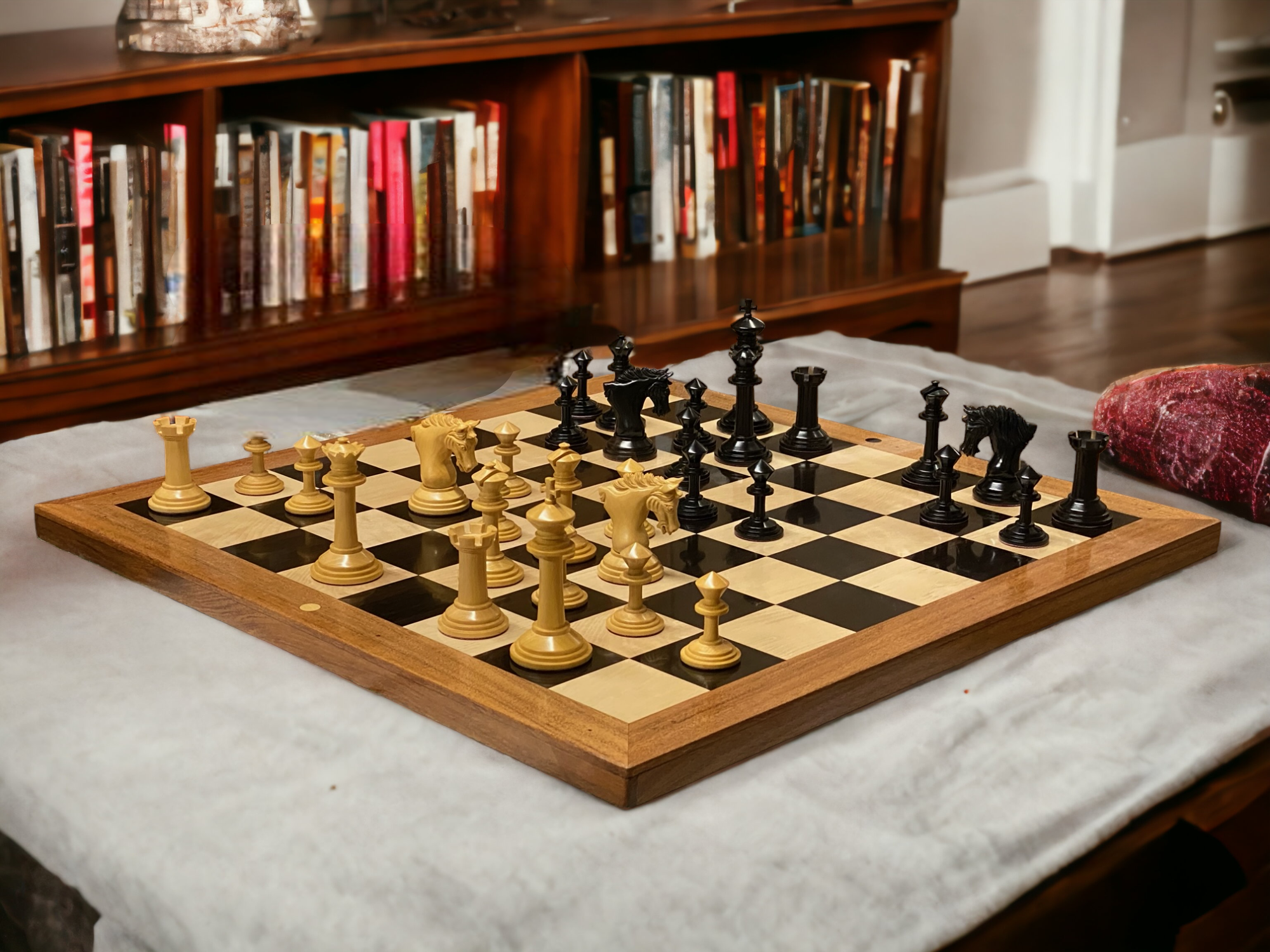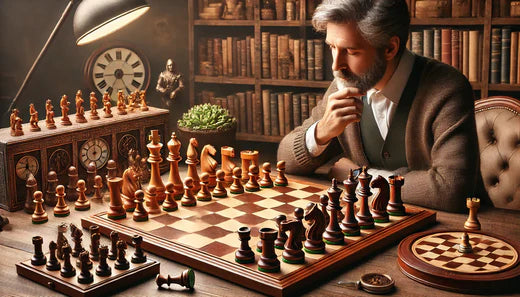Embarking on a Chess Odyssey with The English Chess Company
Welcome to a realm where intellect meets strategy, where ancient roots intertwine with modern elegance – the world of chess. At The English Chess Company, we are not just retailers; we are enthusiasts sharing the intricate tales of chess pieces, the historical significance of the game, and the exquisite sets that grace our collections.
A. Origins of Chess: Unravelling the Enigma
-
Ancient Beginnings: Tracing Chess to its Roots
- Explore the earliest mentions of chess-like games in various cultures.
- Uncover the evolution from precursor games to chess as we know it today.
-
Chess in the East: From Chaturanga to Shatranj
- Trace the game's journey through India and Persia.
- Discover the predecessors like Chaturanga and Shatranj.
-
The Silk Road Connection: Chess Spreads Across Continents
- Examine how chess travelled along trade routes.
- Understand the cultural adaptations that occurred.
-
Chess, with its intricate strategies and timeless appeal, finds its origins shrouded in the mists of ancient history. To truly understand the game, one must embark on a journey through time, tracing chess-like games in various cultures.
In the heart of ancient India, a precursor to chess emerged, known as Chaturanga. Its roots can be traced back to the Gupta Empire, around the 6th century AD. Chaturanga, meaning "four divisions of the military," reflected the composition of the army: infantry, cavalry, elephants, and chariots.
As the game traversed through the silk routes, it found a new home in Persia, where it evolved into Shatranj. The Persian nobility embraced Shatranj, and it became a pastime among the ruling class. The game gradually made its way westward, reaching the Islamic world and capturing the imaginations of scholars and enthusiasts alike.
2. Chess in the East: From Chaturanga to Shatranj
Chess found a haven in the Islamic world, where it underwent significant transformations. Scholars like al-Adli ar-Rumi documented the game's rules, providing a clearer structure. Shatranj, as played in the medieval Islamic world, featured familiar elements, including the royal vizier (our modern-day queen) and the chariot (later evolving into the rook).
The game continued its journey, spreading across the Islamic caliphates, influencing cultures and evolving in parallel. It was during this time that chess reached Europe, carried by traders and travellers along the intricate network of the Silk Road.
3. The Silk Road Connection: Chess Spreads Across Continents
The Silk Road, a network of trade routes connecting the East and West, served as the conduit for not only goods but also ideas and culture. Chess, with its intellectual allure, became a cultural ambassador as it travelled across continents.
In the medieval courts of Europe, chess gained popularity among the nobility. The game underwent further modifications, aligning with the changing cultural dynamics of the time. The queen's power expanded, reflecting the evolving status of women in society.
Chess had successfully traversed continents and centuries, transforming from the ancient Chaturanga to the medieval Shatranj and evolving into the game we recognize today. This rich tapestry of history laid the foundation for the strategic masterpiece that captivates minds worldwide.
B. The Medieval Chess Revolution
-
The Birth of Modern Chess: Evolution of Rules
- Investigate how modern chess rules emerged.
- Explore the significant changes during the medieval period.
-
Chess and Royalty: A Game for Kings and Queens
- Delve into the connection between chess and medieval royalty.
- Highlight the symbolic importance of the game.
-
The Mysterious Queen's Power: A Historical Perspective
- Explore the evolution of the queen's role on the chessboard.
- Understand the symbolism behind the queen's power.
-
The medieval period heralded a transformative era for chess, marking the birth of the modern game we recognize today. During this time, significant changes in the rules and structure of chess laid the groundwork for the strategic masterpiece it would become.
In the 15th century, Spain witnessed a pivotal moment with the publication of "Libro de la invención liberal y arte del juego del Axedrez" (The Book of the Liberal Invention and Art of the Game of Chess) by Lucena. This seminal work provided a comprehensive guide to chess, including openings, strategies, and endings. It was during this period that several critical changes occurred.
One of the most notable transformations was the enhanced mobility of the queen. In the original Shatranj, the queen (then known as the vizier) moved only one square diagonally. However, Lucena's work introduced the powerful diagonal movement that characterizes the modern queen. This modification elevated the queen to a formidable force on the chessboard, altering the dynamics of the game significantly.
Another key development was the introduction of castling. This strategic manoeuvre allowed the king and rook to move simultaneously, contributing to the safety of the king while activating the rook for an offensive or defensive role. The inclusion of castling marked a crucial step in refining the balance between offense and defense in chess.
2. Chess and Royalty: A Game for Kings and Queens
The medieval period witnessed chess becoming more than just a pastime; it became a symbol of nobility and intellect. Chess boards adorned the courts of kings and queens, with the nobility using the game not only for entertainment but also as a tool for strategic thinking and diplomatic manoeuvrings.
As chess became associated with royal courts, it gained a certain prestige. The social status of the game elevated, and its strategic depth made it a favourite pastime among monarchs. The symbolic representation of the king and queen on the chessboard mirrored the hierarchy of medieval society, further cementing the game's connection with the ruling class.
The nobility's patronage of chess also led to the creation of exquisite chess sets crafted from precious materials. These sets became status symbols, showcasing the wealth and sophistication of the aristocracy. Intricately carved pieces, often reflecting the personalities of the ruling figures, turned chess into a work of art.
3. The Mysterious Queen's Power: A Historical Perspective
The evolution of the queen's power during the medieval period is a fascinating chapter in the history of chess. The transition from the limited movement of the vizier in Shatranj to the dynamic and far-reaching power of the queen introduced a new layer of complexity to the game.
As societies evolved and notions of queenship transformed, so did the role of the queen on the chessboard. The queen became a symbol of strength, intelligence, and strategic prowess. This transformation not only mirrored societal changes but also enhanced the strategic depth of the game.
In summary, the medieval period marked a chess revolution. The rules were refined, strategies were honed, and chess became intricately entwined with the cultural and societal dynamics of the time. The game that emerged from this period set the stage for the enduring legacy of chess, captivating minds across centuries and continents.
II. A Tale of Chess Pieces:
A. Pawns to Queens: The Hierarchy on the Board
-
Pawns: Foot Soldiers of the Chessboard
- Examine the unique roles and strategic importance of pawns.
- Discuss pawn structures and their impact on the game.
-
Knights: The Elegant Steeds in Chess
- Highlight the unique movement of knights.
- Explore the strategic nuances of knight manoeuvres.
-
Bishops: The Diagonal Strategists
- Discuss the role of bishops in controlling diagonals.
- Explore tactics involving bishops.
-
Rooks: The Castles That Guard the Kingdom
- Highlight the power and versatility of rooks.
- Explore common endgame scenarios involving rooks.
-
Queens: The Most Powerful Piece on the Board
- Delve into the historical evolution of the queen's power.
- Discuss strategic considerations when deploying the queen.
-
Kings: The Ultimate Objective
- Explore the unique vulnerabilities and strengths of the king.
- Discuss the importance of king safety.



